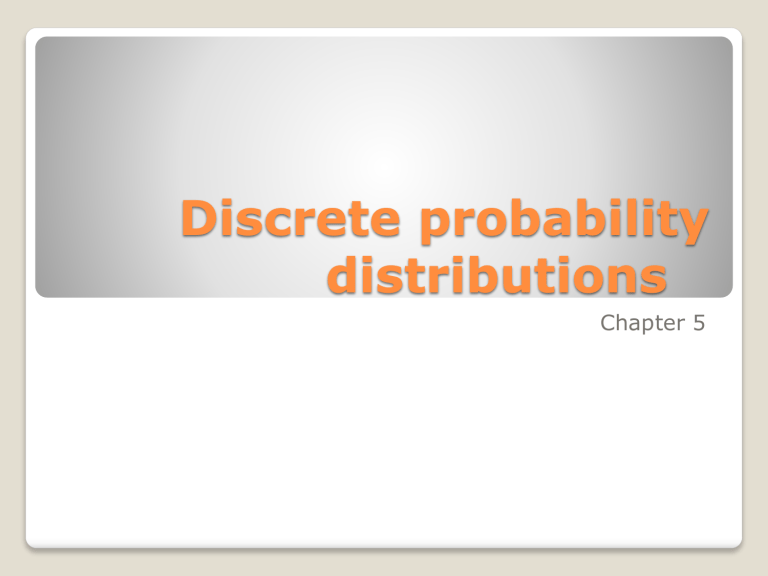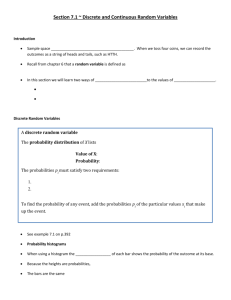Discrete probability distributions

Discrete probability distributions
Chapter 5
Section 5-1: Introduction
Section 5-2: Probability Distributions
Section 5-3: Mean, Variance, Standard
Deviation and Expectation
Section 5-4: The Binomial Distribution
Section 5-6: Summary
Outline
This chapter will deal with the construction of discrete probability distributions by combining methods of descriptive statistics from Chapters 2 and
3 and those of probability presented in
Chapter 4.
A probability distribution, in general, will describe what will probably happen instead of what actually did happen
Overview
Combining Descriptive Methods and Probabilities
In this chapter we will construct probability distributions by presenting possible outcomes along with the relative frequencies we expect .
Many decisions in business, insurance, and other real-life situations are made by assigning probabilities to all possible outcomes pertaining to the situation and then evaluating the results
◦ Saleswoman can compute probability that she will make 0, 1, 2, or 3 or more sales in a single day.
Then, she would be able to compute the average number of sales she makes per week, and if she is working on commission, she will be able to approximate her weekly income over a period of time.
Why do we need probability distributions?
Section 5-2 Probability Distributions
Objective: Construct a probability distribution for a random variable
A random variable is a variable whose values are determined by chance
Typically assumes values of 0,1,2…n
4 step process
Chance Experiment which leads to
Sample Space which leads to
Definition of a Random Variable which leads to
A Probability Distribution
Random Variable and Probability
Distributions
Discrete Variables (Data)—
Chapter 5
Can be assigned values such as 0, 1, 2,
3
“Countable”
Examples:
Number of children
Number of credit cards
Number of calls received by switchboard
Number of students
Continuous Variables
(Data)---Chapter 6
Can assume an infinite number of values between any two specific values
Obtained by measuring
Often include fractions and decimals
Examples:
Temperature
Height
Weight
Time
Remember
Consists of the values a random variable can assume and the corresponding probabilities of the values.
The probabilities are determined theoretically or by observation
Can be shown by using a graph (probability histogram), table, or formula
Two requirements:
The sum of the probabilities of all the events in the sample space must equal 1; that is,
S P(x) = 1
The probability of each event in the sample space must be between or equal to 0 and 1.
That is, 0 < P(x) < 1
Discrete Probability Distribution
Example: Determine whether the distribution represents a probability distribution. If it does not, state why.
x 1 2 3 4 5
P(x) 0.3
0.1
0.1
0.2
0.3
x 3 6 8 12
P(x) 0.3
0.5
0.7
-0.8
Based on past results found in the
Information Please
Almanac, there is a
0.1818 probability that a baseball World Series contest will last four games, a 0.2121 probability it will last five games, a 0.2323 probability that it will last six games, and a
0.3737 probability that it will last seven games.
In a study of brand recognition of Sony, groups of four consumers are interviewed. If x is the number of people in the group who recognize the Sony brand name, then x can be 0, 1, 2, 3, or 4 and the corresponding probabilities are
0.0016,0.0564,
0.1432, 0.3892, and
0.4096











